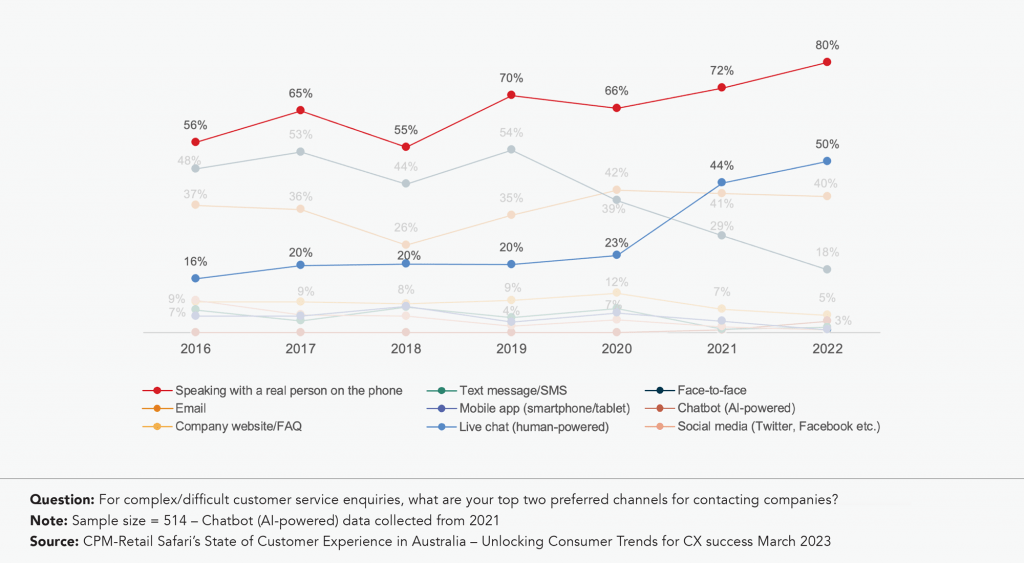
For Australian consumers, great customer service is about consistently receiving the right information and knowledgeable help. It’s no surprise then that improving customer experience is a top priority for Australian businesses.
To better understand Australian consumers’ perceptions of what makes for CX excellence, we partnered with Swinburne University’s CXI Research Group to undertake our annual state of customer experience in Australia survey.
This year’s CX research report: “The State of Customer Experience in Australia – Unlocking Consumer Trends for CX success” builds on data collected in our annual surveys since 2016. We compared the survey results to historical data and trends, where we explore the ongoing evolution of the Australian customer experience, changing customer needs, and factors that are critical for success.
The research reveals that the impact of customer experience on future purchasing decisions is real – and it isn’t changing, the importance of having real people on the customer service front line, and much more.
The most important factors impacting excellence
What Australian consumers value most in their customer service has changed in recent years. For Australians, great customer service is about getting the right information, consistent information across both digital and human interactions and knowledgeable help.
Outcome of bad customer experience
Our survey shows that a negative customer experience has a significant impact on whether consumers purchase from a company again – with these results being consistent over the last four years. Following a negative customer service experience, over one-third of customers stopped shopping at a company in the past year. This result clearly demonstrates that consumer attitudes towards receiving bad experiences has costly consequences for businesses.
Top reasons for stopping purchasing
The most common reasons to stop purchasing from a company are generally linked with how the company handles interactions with its customers. Australian consumers expect knowledgeable staff, first contact resolution and human representatives. If they don’t receive these, they may stop purchasing from a company.
Customer service preferred contact channels
For simple enquiries, Australians have increased their preference for a broader range of digital service channels for simple enquiries. Company websites/FAQs and live chats (human-powered) have become the top preferred channels for simple queries.
For more complex or difficult enquiries, customers have a higher preference for human touch channels. Speaking with a real person over the phone remains by far the channel of choice for complex enquiries across all age groups.
The proportion of consumers preferring to use human assisted channels rather than self-service channels for difficult queries has been increasing across all age groups since 2016. This trend continued in 2022, with more consumers than ever preferring to speak to a real person on the phone (80%) or via live chat (50%).

Since 2019, live chat (human-powered) has more than doubled as a preferred channel for complex enquiries (20% -> 50%). Conversely, face-to-face interactions are trending downwards (54% -> 18%).
The decrease in the popularity of face-to-face interactions is likely due to the impact of COVID-19 on consumer behaviour, and subsequent increasing interest in using other type of customer service channels that don’t require travelling and/or in-person interactions.
Key Takeaways to improve the CX
Here we present insights and strategies derived from our research that businesses can use for improving customer experience into the future.
Great customer experiences come from quality interactions with real people
Whether in-person, on the phone or online, knowledgeable staff who can deal effectively with both simple and complex queries and problems are the key to good customer experiences for Australians. On the flip side, service that fails to meet the perceived needs of customers drives them away and leads to negative word-of-mouth – costing sales.
Consider live chat via Virtual Product Advisors
Speaking with a real person via live chat is a popular channel for both complex and simple enquiries. Additionally, many online customers want help from a live person while they are shopping online. By connecting virtually with customers, Virtual Product Advisors provide interactive, live, one-way video chat conversations with customers via a website, assisting customers through their purchasing journey with their expert product and service knowledge, providing a positive customer experience, and helping convert shoppers into buyers.
Poor customer experiences hurt the bottom line
Poor customer experiences have costly consequences for businesses: over one-third of Australian consumers have stopped purchasing from a business after a bad experience, predominantly related with how companies handled interactions with their customers. To maintain consistently great customer experiences – and improve reputation and sales – businesses need to ensure they have knowledgeable representatives who can solve customer queries at the first opportunity.
To learn valuable new, actionable insights and strategies that will help direct and drive your CX strategy, download The State of Customer Experience in Australia Report here.
Contact us for further information on Virtual Product Advisors.



